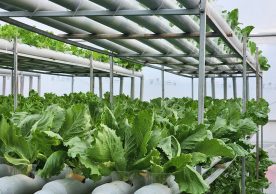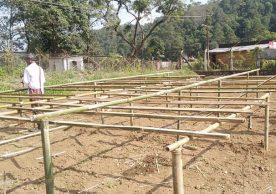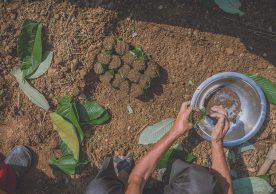
Urban areas – such as Kathmandu – do not have arable land and are dependent on farms elsewhere that use large amounts of water, pesticides, and chemical fertilizers in growing crops. One solution to this problem is urban vertical farming (UVF), which is based on a hydroponics system that uses water to grow plants. We have designed systems that are compact and mobile, can be set up on rooftops, and can also be modified for indoor areas. Best suited for salad greens and green leafy vegetables with short growth cycles, these systems are water and power-efficient. This solution warrants wider application in the cities in Nepal.
The issue of how food is produced, transported, and consumed is acquiring greater salience in the context of climate change and rapid urbanization. It has a bearing on carbon dioxide emissions, and on people’s health and well-being. It calls for innovative solutions given the limitations of space in most urban areas.
The problem
By 2050, the world’s population will exceed 9 billion and its urban population is expected to double in size. As cities lack arable land, urban societies heavily depend on importing vegetables and fruits from peri-urban or rural areas near and far. Production on local farmlands near cities is decreasing due to the vagaries of a changing climate. For this reason, and to meet the growing demand for food, commercial farmers are forced to use chemical fertilizers and pesticides, but often do so in a haphazard manner. This leads to the gradual deterioration of soil health, which ultimately lowers agricultural yields. It has also been shown to have very grave effects on people’s health. Traditional farming methods also consume vast amounts of water, a resource that is increasingly under stress in a climate change context. Some of these are also issues in the Kathmandu Valley, whose population has been growing steeply in recent decades.
The solution
 In a city like Kathmandu, one way of providing fresh food and vegetables full of nutrients is via urban vertical farming (UVF). UVF is a Nutrient Film Technique (NFT) based on a hydroponics system that works on the continuous flow of water past plant roots, with the nutrient solution mixed in it.
In a city like Kathmandu, one way of providing fresh food and vegetables full of nutrients is via urban vertical farming (UVF). UVF is a Nutrient Film Technique (NFT) based on a hydroponics system that works on the continuous flow of water past plant roots, with the nutrient solution mixed in it.
The nutrient solution is pumped from a reservoir into PVC pipes holding the plants, and then flows back into the reservoir. This cyclical process ensures the optimum utilization of water and minimizes the volume of water required to restock the system. This technique is best suited for salad crops and green leafy vegetables such as lettuce and spinach, which have short growth cycles. With a design optimized for compactness and mobility, the system can be easily set up on personal rooftops.
Implementation
Our basic model is HP-120, which can accommodate up to 120 plants. Its dimensions are 5 ft. × 2.5 ft. × 5 ft., and have three tiers, each tier holding four interconnected PVC pipes. Each pipe has 10 holes to place the plants, and hence there can be up to 40 plants in each tier. It requires an electric motor of only 18 watts to pump the water in the system.
Another compact model is HP-240, which can accommodate 240 plants. Its dimension is 5 ft. × 2.5 ft. × 6 ft. and with four tiers, each tier holding six PVC pipes. Each pipe has 10 holes for the plants, and hence 60 holes in each tier, 240 in total. Both systems require an area of only two square Meters.
We also provide customized designs according to the available rooftop area and the needs of our customers. The UVF is best suited for a greenhouse or rooftop. However, with a little advancement in design and technology, these can be modified for indoor spaces as well. They can also be run using alternative renewable energy sources such as solar power.
Results and benefits
The UVF enables one to grow food very close to the point of consumption, and all year round. By growing its own greens, the city would go from one that feeds on land, water, and energy elsewhere to a self-sustaining ecosystem.
In addition to the food and nutritional benefits, this system consumes 70–95 per cent less water compared to traditional farming systems. Hence, it would be highly and practically possible to scale up in water-scarce urban areas such as Kathmandu Valley. We have sold over 35 systems in three years, and it warrants much wider application not just in Kathmandu but in any other rapidly growing city in Nepal with declining groundwater availability.
Contact
Eni Shrestha
WindPower Nepal Pvt. Ltd
Email: shresthaeni@gmail.com
Contact: +977-9851311537
SDG linkages
Each of the RMS solutions are linked to the 2030 Sustainable Development Goals outlined by the UN in 2015. The SDGs that this intervention contributes to are as follows:












